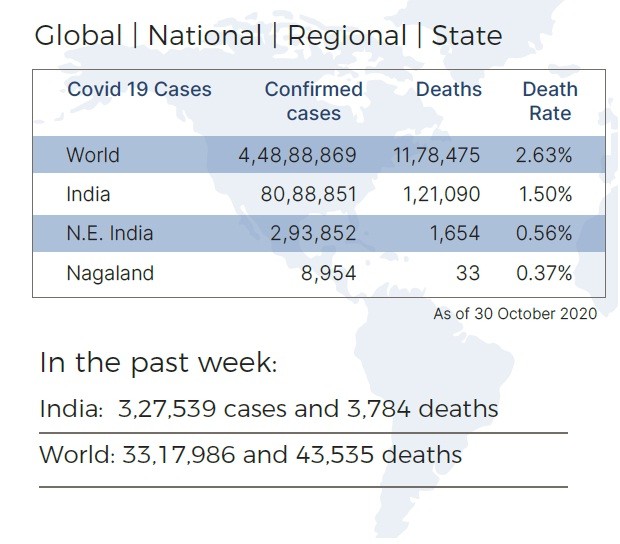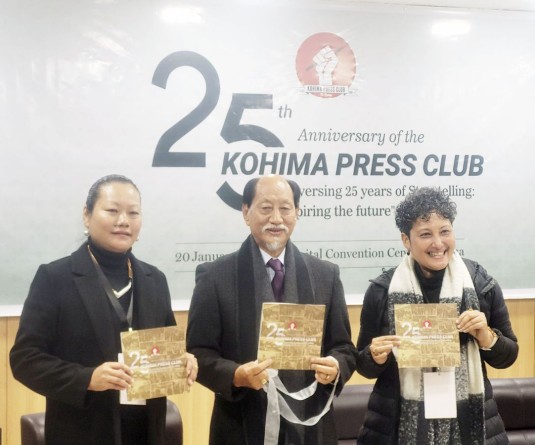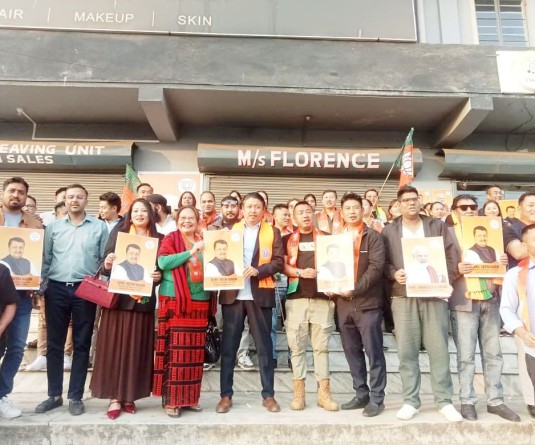Global, national, regional, and state status of COVID-19 as of October 30. (Image: IDSP, DOHFW Nagaland)

Morung Express News
Dimapur | November 1
Even as India’s COVID-19 graph made a gradual dip in October, case detection saw resurgence in other parts of the word, especially in Europe.
According to the state Integrated Disease Surveillance Programme (IDSP), Health & Family Welfare (H&FW), the past week recorded the maximum number of infections, worldwide, in a single week. As on November 1, the worldwide case total was over 4.6cr with 5 lakh-plus cases being reported daily on October 28, 29 and 30.
“Europe continues to see the maximum number of cases for the second week in a row as the winter wave continues its surge with hospitals and ICUs reaching maximum occupancy,” stated the IDSP in its weekly COVID report released on October 31.
7 European nations, including the UK and Russia, were in the 20 most affected countries. Russia (4th), France (5th), Spain (6th), UK (9th), Italy (13th), Germany (15th) and Belgium (18th) are currently in the midst of a significant resurgence in cases, as per worldometers.info statistics.
The case count in the USA continued to surge, nearing the 1cr mark. On October 30, the country with the most COVID cases, recorded a single-day high of over 1 lakh cases. Its North American neighbour, Mexico was in 10th place with over 9 lakh cases.
The South American countries of Brazil, Argentina, Colombia, Peru and Chile also featured in the list of the 20 most affected countries with Brazil, third in terms of case count, after the USA and India.
The IDSP report stated that south-east Asia and India showed some decline in case detection and deaths. India’s recovery rate was well over 90 percent with almost 75 lakh recoveries against 81.8 lakh reported cases as on Sunday.
Meanwhile, Nagaland’s case count of 9075 maybe relatively low, but, as reiterated by the IDSP, a high sample positivity rate has become a cause for concern. The state’s detection rate has consistently remained higher than the national average in recent weeks.
As on November 1, the positivity rate was 9.2 percent of 98,575 samples. Today’s 28 cases were out of 300 samples tested, returning a positivity rate of 9.3 percent.
The nationwide positivity rate was 7.4 percent, as on October 30.
By official accounts, the level of transmission in Nagaland has so far been confined to “local spread.” But rising incidence of positive traced contacts has had the state Health & Family Welfare Department apprehensive of the situation transforming into community spread.
Community spread is defined as infections with no known exposure or source of infection.
As reported by the IDSP in its weekly COVID report published on October 31, 57 percent of cases detected in October were from traced contacts. The number of traced contacts in today’s 28 cases was 6.
Control and intervention
Adhering to the Standard Operating Procedure as published by the health authority would, to a great extent, control spread and preventing the health establishments from being overwhelmed, the IDSP has stated time and again.
Avoiding the ‘3 Cs’ (crowded places, close-contact settings and confined or enclosed settings) and following the ‘3 Ws’ (wear mask, wash hands and watch/safe distance) should be the motto. Avoiding casual travel, social events, dining out, shopping (unless for essentials) and temporarily reducing workforce in workplaces (except the essential services) would also go a long way.
As far as intervention was concerned, the IDSP report said that early intervention is “critical in saving a life and in avoiding post-COVID sequelae (after effects of a disease).”
“Citizens should contact the helpline and seek medical care immediately without delay. Many deaths have happened due to patients presenting late in the hospital. The timing of Oxygen or steroid therapy along with other proven interventions if done timely could be lifesaving,” it said, while emphasizing, “It is all about the TIMING.”
Unwilling to name contacts
According to the IDSP, contact tracing is an effective time-tested method to break the transmission of any infectious disease with the “traced contacts” isolated and tested by the surveillance teams.
Despite, the IDSP said that an alarming trend of positive cases “not naming contacts to the contact tracing teams due to pressure from peers” is occurring in the state. It cautioned, “If you do not name contacts or come for testing, you are directly involved in spreading the disease. This is a punishable offence under the Epidemic Diseases Act. The digital surveillance teams and cyber security are on track to identify such offenders.”
While stating that testing is free for whoever falls under the contact tracing list and for symptomatic cases, it said that every citizen has a moral responsibility to keep the community safe.
Secondary attack rate is defined as the probability that the infection occurs among susceptible persons from a primary case.
This rate in the same household varies from 4 percent to around 50 percent across the globe. In the same house, if someone is positive, the chances of getting another family member infected ranges from 4 to 50 percent. The factors which increase chances of infection are symptomatic primary cases, elderly, co-morbid conditions, non-adherence to safety measures, even natural immunity and other factors in the host, which is still not fully understood. The timing of the sampling is also critical. The same technology and method of testing as anywhere in the world is used in the state.
Courtesy: State IDSP, H&FW, Nagaland.





